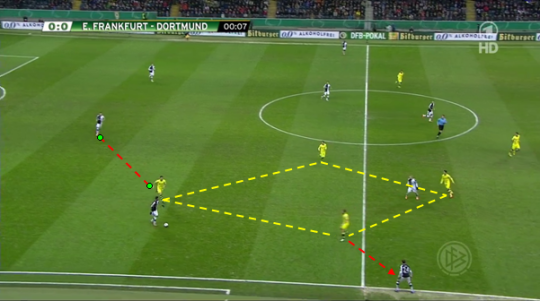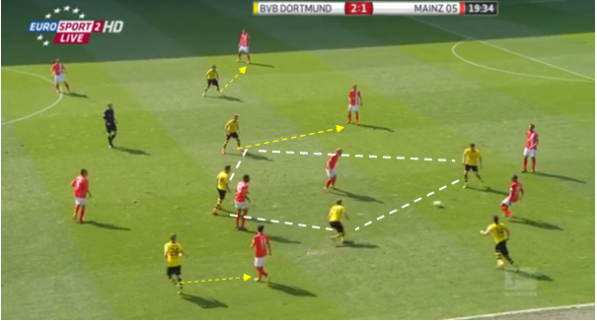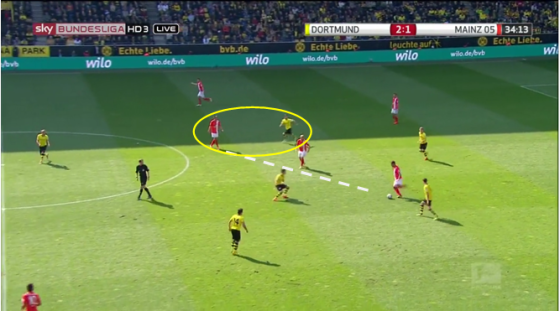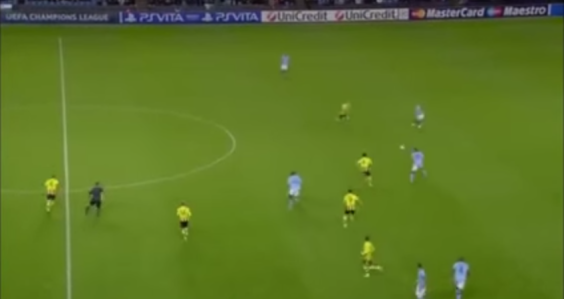 Football is an ever-evolving and progressive sport. There are many interpretations of the game and tactical systems implemented and the great thing about football is it’s diversity. We have often heard of possession football as a form of defense, Pep spoke about it recently; “Sometimes you have loads of possession but do not create chances, just to defend and defend – because when you have possession, you have the ball and it is impossible the opponent can score a goal”
Football is an ever-evolving and progressive sport. There are many interpretations of the game and tactical systems implemented and the great thing about football is it’s diversity. We have often heard of possession football as a form of defense, Pep spoke about it recently; “Sometimes you have loads of possession but do not create chances, just to defend and defend – because when you have possession, you have the ball and it is impossible the opponent can score a goal”
Also the general philosophical adage ‘Attack is the best form of defense’ used in military and tactical games and also commonly applied to football, antithetically, is ‘defending’ a source of attack in the modern game?
In recent years, the rise of pressing in the tactical landscape is evident, and perhaps testament to it’s importance. Tasotti defined pressing as an organized form of defending in which the opposition player in possession is pressurized with the aim of regaining or winning possession. Sacchi also explained; “Pressing is not about running and it’s not about working hard. It’s about controlling space”. They are many variations to it however the main idea behind pressing is to restrict the space and time a player in possession or supporting players with pressure.
Pressing is widely seen as a form of defensive transition, however for Dortmund it is their main source of chance creation. Dortmund’s recent meteoric rise has been credited to their very modern tactics, none more so than their effective use of pressing both as a form of defense and attack.
Contemporary football is ball-oriented defense to operate Pressing fast with people who constantly put pressure on the opponent and quickly switch from defensive to offensive”
“The offensive players benefit from the fact our counter-pressing is so good, because we get to the other team’s goal much quicker,” Klopp told FFT. “But in a way that’s just a bonus. The idea of counter-pressing, Klopp says, is that it’s “the shortest route to defence”.
Dortmund are a club synonymous with energy and intensity right from the fans of the famous yellow wall to the players. Klopp has set up a very energetic, tactical and technically superior side which spend a lot of time in training working on pressing drills and tactics. “The pressing game is important for us,” Lewandowski explained “It is our strength and we work on it all the time. We train it constantly.” They carry out pressing not only as a form of defense to win possession but primarily as a form of attack in the opposition third. Klopp once said; “Gegenpressing is the best playmaker there is. The best moment to win the ball is immediately after your team just lost it. The opponent is still looking for orientation where to pass the ball.”
To break this down, it is a fact that if a team is in their structured defensive shape they are difficult to wear down, as compared to the transition phase where spaces are open and teams are susceptible. The notion behind Dortmund’s high’s press is simple: when opponents have the ball they try to attack and and break out of their defensive shape, as a result when possession is won through the high press the opposition is out of their shape and can be exploited. Dortmund’s pressing has well coordinated movements and has a lot of variations to it. They have a lot of pressing triggers such as; back passes, a player facing his own-goal, a square pass between defenders, poor touches, throw-ins etc and also set a lot of pressing traps to lure opponents into playing the ball into an area that benefits them.
Michael Carrick: “Force the opposition to play the ball where you want. Do this by stepping off the player you are marking and drawing them into a pass, then trying to intercept it.” Lets take the above screenshot for example, Dortmund in a diamond-like pressing shape move to the ball side and apply pressure to win possession against Frankfurt. BVB striker Lewandowski positions himself to block the passing options to the player positioned between the two defenders and is simultaneously applying pressure to the player in possession restricting time and space in possession. The opponent under pressure may play long which gives Dortmund a higher chance of regaining possession through the defenders, or attempt to keep circulating the ball in the defensive/middle third. On many occasions we have seen players fall directly into Dortmund’s pressing trap. In the above screenshot if the ball is passed to the right sided CM he is quickly pressed by three players and if there is a turn over if possession, BVB have already bypassed most of Frankfurt’s lines and have a quicker route to goal as well as the numbers.
Lets take the above screenshot for example, Dortmund in a diamond-like pressing shape move to the ball side and apply pressure to win possession against Frankfurt. BVB striker Lewandowski positions himself to block the passing options to the player positioned between the two defenders and is simultaneously applying pressure to the player in possession restricting time and space in possession. The opponent under pressure may play long which gives Dortmund a higher chance of regaining possession through the defenders, or attempt to keep circulating the ball in the defensive/middle third. On many occasions we have seen players fall directly into Dortmund’s pressing trap. In the above screenshot if the ball is passed to the right sided CM he is quickly pressed by three players and if there is a turn over if possession, BVB have already bypassed most of Frankfurt’s lines and have a quicker route to goal as well as the numbers. Here, Dortmund press high very aggressively with up to seven players concentrated in the Mainz area. They all have a man and stay tight leaving only the player in the middle of the web unmarked. With the player facing his goal he has little awareness of the players behind him and this is a pressing trigger for Klopp’s side. BVB’s counterpress blocks most passing lanes and forces the ball carrier to play the ball to the player in the center of the web who is quickly pressed by three/four Dortmund players. A turnover in possession would see Dortmund have a quicker route to goal as well as a potential 5v4 situation against the Mainz defense.
Here, Dortmund press high very aggressively with up to seven players concentrated in the Mainz area. They all have a man and stay tight leaving only the player in the middle of the web unmarked. With the player facing his goal he has little awareness of the players behind him and this is a pressing trigger for Klopp’s side. BVB’s counterpress blocks most passing lanes and forces the ball carrier to play the ball to the player in the center of the web who is quickly pressed by three/four Dortmund players. A turnover in possession would see Dortmund have a quicker route to goal as well as a potential 5v4 situation against the Mainz defense.
In the same game, Dortmund again press immediately after losing the ball in the Mainz area
 After intercepting the pass, Mkhitaryan is already in the Mainz half and a quick pass to Marco Reus puts him through on goal.
After intercepting the pass, Mkhitaryan is already in the Mainz half and a quick pass to Marco Reus puts him through on goal.
 Here, BVB apply pressure to Man City who try to circulate possession in their defensive third. Rodwell plays a square pass which is intercepted by Reus.
Here, BVB apply pressure to Man City who try to circulate possession in their defensive third. Rodwell plays a square pass which is intercepted by Reus.  By winning the ball in that particular zone, City are out of shape and Reus is able to run clean on goal to score for Dortmund. “The hardest thing about an easy match is making a weak opponent play poor. A poor player isn’t poor because he tends to kick the ball in his own goal. It’s because when you put intense pressure on him, he loses control. So you have to increase the tempo of the game and he’ll automatically give the ball away.”- Johan Cruyff
By winning the ball in that particular zone, City are out of shape and Reus is able to run clean on goal to score for Dortmund. “The hardest thing about an easy match is making a weak opponent play poor. A poor player isn’t poor because he tends to kick the ball in his own goal. It’s because when you put intense pressure on him, he loses control. So you have to increase the tempo of the game and he’ll automatically give the ball away.”- Johan Cruyff In this Champions League game vs Arsenal, Dortmund once again proved gegenpressing is the best playmaker. Reus’ pass from the left wing to Lewandowski was intercepted by Arteta who plays a square pass to his midfield partner Ramsey. Immediately after losing the ball, Reus and Lewandowski apply pressure to Ramsey and regain possession just 20meters from the Arsenal goal. Lewandowki who pinches the ball plays a quick pass to Mkhitaryan on his right, who scores to put BVB ahead at the Emirates. Quite effective eh?
In this Champions League game vs Arsenal, Dortmund once again proved gegenpressing is the best playmaker. Reus’ pass from the left wing to Lewandowski was intercepted by Arteta who plays a square pass to his midfield partner Ramsey. Immediately after losing the ball, Reus and Lewandowski apply pressure to Ramsey and regain possession just 20meters from the Arsenal goal. Lewandowki who pinches the ball plays a quick pass to Mkhitaryan on his right, who scores to put BVB ahead at the Emirates. Quite effective eh?
Borussia Dortmund aren’t the only team to employ this tactic successfully. Bayern Munich under Juup Heynckes got a great number of goals through counterpressing. Pep at Barcelona too and the German NT. “The attackers of Bayern, when they didn’t have the ball, were their first defenders” – Sacchi. High pressing has become one of the major tactical trends in the past couple of years. By regaining possession in higher areas, the path to goal is say 20-30meters rather than having to construct or initiate attacks from deep. “Pressuring high limits the amount of running players must do. When you win back the ball, there are 30 metres to goal rather than 80″ – Cruyff
excellent post and very informative!!!
LikeLike